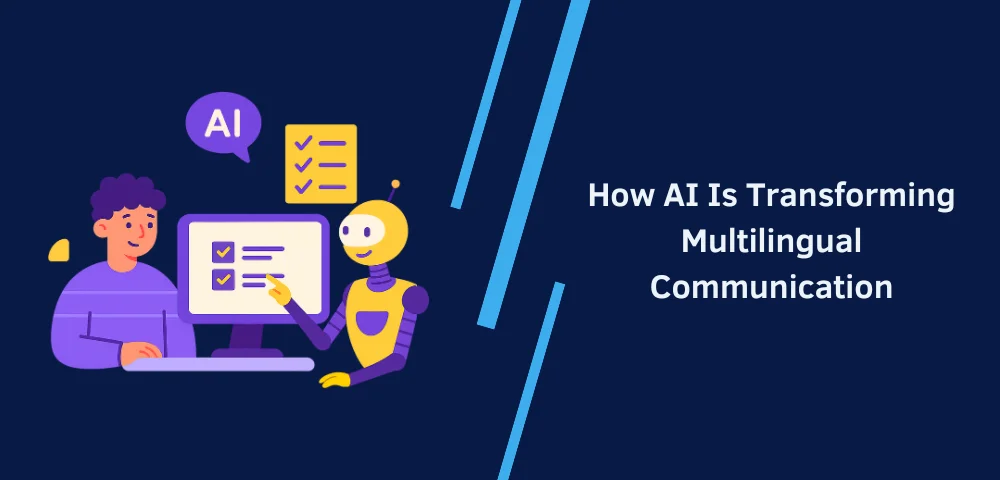If you’ve ever been on a video call with people from three different continents, you’ll know the feeling: long pauses, confused looks and a nagging sense that you’re losing precious time.
I once spent an hour in a cross‑cultural meeting where we managed to discuss only two agenda items. We’d take turns talking, then our interpreter would funnel each comment through one language after another.
By the time it came back to me I’d forgotten half of what I wanted to say.
The conversation felt like it was moving through treacle. Afterward we laughed about it and joked that maybe we should all learn each other’s languages.
In our connected age those awkward moments aren’t rare. A support agent in India can be chatting with shoppers in Germany in the morning and Brazil in the afternoon.
A small company in Nigeria might want to launch its app in Spanish, Japanese and French without hiring three full‑time translators.
Doing everything by hand quickly becomes impossible. That’s why so many people are turning to artificial intelligence. What started as a quirky science project now quietly powers chat services, caption tools and marketing platforms.
No wonder businesses and everyday users are flocking to smart tools: in just a few years, what was once a novelty has turned into a reliable partner for bridging languages – and it’s only picking up speed.
A brief history of machine translation
Early attempts at automatic translation were rule based.
Programmers wrote long lists of grammar rules and vocab pairs. Those systems could handle straightforward sentences but fell apart when they met idioms or jokes.
Later, statistical models came along. They used probabilities from large corpora to guess the best translation. Better, but still hit or miss.
The breakthrough came with neural networks. Feed them millions of sentence pairs and they learn patterns humans can’t see.
They don’t just substitute words; they build a sense of what a sentence means and express that idea in another language.
If you’ve compared old translations with ones generated today, you’ve seen the leap in quality.
Why neural networks matter
Modern translation engines try to understand context. Tell one of the early programs that someone “kicked the bucket” and it would dutifully translate each word.
A neural model, having seen that phrase in all sorts of stories and conversations, knows it usually means “died” and picks the right expression.
Why do they do better?
Because they soak up patterns from mountains of bilingual text and look at the whole sentence instead of word by word. Here are a few reasons these systems work so well:
- The internet has produced a huge amount of bilingual text. Songs, social posts, subtitles and manuals all become training material.
- Engineers figured out how to take a big language model trained on general data and fine‑tune it for specific tasks. That’s transfer learning, and it helps especially with languages that don’t have a lot of written resources.
- Specialised engines exist for sensitive fields. A legal translation engine includes glossary terms and sample contracts so it doesn’t mangle clauses.
- The biggest shift may be in us. People no longer treat AI like a novelty; they are willing to bet budgets on it because it helps them meet deadlines and avoid repetitive work.
From text to voice: conversations without borders
Text is only half the story.
What about voice?
Speaking through an app that translates on the fly once sounded like science fiction.
These days I hardly think about it. I tap a button, talk into my phone and watch as it turns my words into text, turns that text into another language and then speaks it out loud.
The first time I tried one of these tools during a call with a friend in Seoul it felt nothing short of magical. We ended up laughing at the novelty, even though the system stumbled occasionally. It was still better than pointing at objects or miming verbs.
Behind the curtain are three moving parts.
First is speech recognition, which listens to what you say and writes it down.
Second is the translation itself.
Third is speech synthesis, which speaks the translated text. Advances in all three have made the process feel natural.
Voices generated by modern synthesizers have emotion and rhythm. Some services even let you clone your own voice so it sounds like you, just speaking Italian or Mandarin.
The fact that people pay for these services shows how much value they offer.
Practical uses of real time translation
You no longer need a separate gadget for this. The big meeting apps have begun embedding translation and caption features natively.
Picture a weekly meeting with colleagues scattered across Tokyo, Paris and Nairobi: they chat away in their first languages and you listen as a pleasant voice speaks your own.
This is not some sci‑fi fantasy – it’s being rolled out in webinars and cross‑border sales calls right now.
The feature isn’t just convenient; it also helps people who prefer reading over listening, or who rely on captions because of hearing loss.
Chatbots and voice assistants have gone multilingual too.
They answer common questions in dozens of languages on websites and through smart speakers. What makes them feel smoother is that they no longer funnel everything through English first.
If a customer writes in Turkish, the software recognises what they’re asking and replies in Turkish, which cuts down on awkward phrasing.
A friend who runs an online shop told me her support bot now fields routine queries from Europe and South America. Her human team still jumps in when something unusual comes up, but the bot takes care of the everyday “Where’s my package?” messages.
Automation in localisation
If you’ve been part of a product team, you know localisation can be a headache.
You tweak a headline, then someone copies it into a spreadsheet, sends it to translators and waits. Days later the translations come back and you paste them into various files. By then the original might have changed again.
AI driven tools make this less painful. When a writer updates text in a content management system, a translation service can automatically generate versions in the languages you support and send them back into the system.
Marketing campaigns can roll out in multiple countries at once, with AI handling the first draft of the local copy. Catchy taglines rarely survive intact across cultures, but with an instant draft you can see what might work and adjust quickly.
A human editor still steps in to polish tone and adjust for cultural nuance, but they’re starting from a complete draft rather than a blank page.
Search engines add another layer.
They favour pages that use the same phrases readers type into the search bar.
Those phrases vary widely from country to country, so an article about healthy snacks needs to include the terms French readers actually use.
Guides to localisation stress the importance of structure and keyword research. Some translation tools now suggest local keywords during the process so your content doesn’t disappear on a foreign results page.
For more effective tips to optimise content for SEO, refer to this guide
Design isn’t all text
Good localisation goes beyond words. Colours, gestures and symbols mean different things to different people.
A thumbs‑up gesture signals approval in some countries but is rude in others. A colour that implies joy in one place may be associated with mourning somewhere else.
Many designers mix icons from random collections and end up with a messy patchwork. A better approach is to stick with a single, coherent icon set that comes with notes about cultural connotations.
That way, when you swap text for a new language, you aren’t also scrambling to fix mismatched visuals.
Social media: local but global
People assume a viral post will work everywhere, but social media is more complex. Pinterest, often overlooked compared to Instagram or TikTok, can be a secret weapon if you know your niche.
I read about a business that created printable colouring pages as freebies. They translated the captions and hashtags, posted at times when users in each country were active and tweaked the visuals to suit local tastes.
The campaign brought in a surprising number of new customers. AI helped by suggesting translations and by analysing which colours and words resonated in each market.
It’s a reminder that global reach and local relevance can go hand in hand.
Not all sunshine
It would be dishonest to pretend AI solves every language problem.
Even the most advanced systems stumble on sarcasm, regional slang and complex jargon.
In areas like law and medicine, an awkward translation can cause real harm.
That’s why experienced linguists still review sensitive material and why businesses don’t rely on machine output alone for contracts or health information.
Bias is another worry. If a model is trained mostly on texts from one region, it may misunderstand or ignore expressions from another.
Companies need to diversify their training data and continuously test for bias.
Privacy concerns are real as well. Streaming your voice off to a cloud service means handing your speech to someone else.
Providers need to earn that trust by being upfront about what they store and why. European privacy laws, for example, place strict rules on how audio can be collected and used, so companies must handle data carefully.
There’s also the human side: professional translators and interpreters worry about being sidelined by machines. In reality their work is evolving.
Many are shifting toward editing, cultural consulting and quality assurance, roles that will remain essential.
Where we’re headed
It’s hard to predict exactly where language technology will go, but some trends stand out. Real time translation keeps getting faster and more accurate.
Industry watchers think general purpose models that handle a variety of tasks will power more translation tools.
The overall demand for language services is growing because businesses of every size are going global. Meanwhile, grassroots organisations and open‑source communities are working to document underrepresented languages.
The more speakers share their vocabularies and stories online, the easier it becomes for AI to learn and support indigenous and minority tongues.
Voice tech is set to become more personalised. Imagine attending a conference and hearing every presenter speak in your language while keeping their emotional tone.
On a practical level, small developers will be able to add these features with a simple AI Voice API instead of reinventing the wheel.
In other words, translation will be baked into the tools we already use rather than being a bolt‑on process.
Closing thoughts
If you’re still reading, you’re probably curious about the same things I am.
Language sits at the heart of our identity, and when we can bridge linguistic gaps, ideas flow that would otherwise be damned up.
Artificial intelligence is part of that story. It lets us translate drafts in seconds, chat across borders in real time and build friendly bots that speak with our customers.
These tools aren’t flawless and they force us to grapple with issues of privacy, bias and the value of human expertise.
Working through those questions will take voices from many fields – engineers, linguists, policymakers and, most importantly, the people who use these tools.
I don’t know exactly how things will look in five years, but I like to imagine a future where you can share a joke with someone halfway around the world and you both laugh at the same time.



